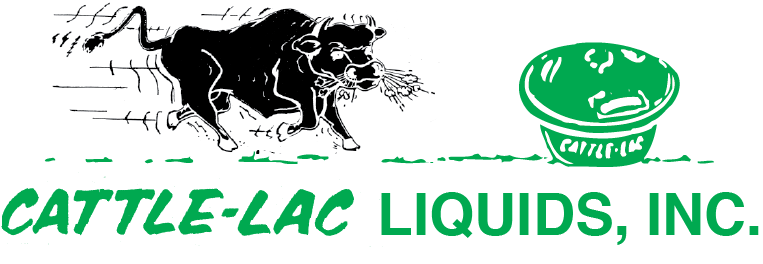While nearly any liquid feed will improve your feed management program, there is a notable difference between liquid feeds. CATTLE-LAC Liquid Cattle Feed is the best overall VALUE! We GUARANTEE that CATTLE-LAC is the best value for your money when you compare tags and results.
The Preferred Feed
CATTLE-LAC Liquid Cattle Feed is the CONSISTENT liquid feed. Our exclusive homogenizing process assures that the feed will stay mixed. CATTLE-LAC contains ONLY nutritious ingredients blended in pure cane “blackstrap” molasses. Believe it or not, other liquid feeds may contain gunky clay or other inert materials to give it artificial thickness, or to lower the price (adulteration). We use organic (natural) proteins in the proper balance with non-protein nitrogen to assure the highest utilization of feedstuffs. NO NEED TO WORRY CATTLE-LAC is formulated to eliminate urea toxicity. COMPARE TAGS! Take a close look at the protein and nutritional analysis among various feeds. Then you be the judge. You’ll find that CATTLE-LAC is outstanding in every category.
Cattle-Lac Feeds are the key to a profitable pasture
CATTLE-LAC liquid supplements help farmers get the very most out of their valuable pasture land. The CATTLE-LAC supplement actually stimulates beneficial bacteria in the cattle rumen, allowing the animal to break down grass roughage faster and easier. The cattle then eat more grass, which means a healthier, heavier animal. The bottom line is that farmers who feed CATTLE-LAC supplements get the maximum amount of meat per acre of pasture.
Green Grass isn’t green enough
The problem with lush green grass alone is too much moisture. While grass contains many important nutrients, water fills up the cattle before they’ve had a chance to consume their daily nutrient requirements.
The Problem with cubes
If you’ve been feeding cubes, here are a few good reasons to switch to CATTLE-LAC liquid supplements: *Cattle will not eat enough grass when you’re feeding them cubes because they just wait to be fed. *You have to feed the cubes once a day, every day. That means extra labor hauling the cubes to the field – rain or shine. *Shy, timid cattle may not get their share of cubes due to “boss” cows. *Cubes get trampled by the herd, wasting the cattle’s feed and your money!
A True Feed management program
Liquid feed is available 24 hours a day, any time the cattle have the need for it. If she’s not getting what she needs from her current diet, she’ll turn to the liquid feed tank to get the proper balance. With liquid feed, your own time and labor requirements are practically nil.

The Economies of Cattle-Lac Liquid Feed
The first question that a producer usually asks is, “how much will a liquid feed program cost me?” This is an important question, since today’s manager must carefully watch his dollars. But successful producers ask the better question, “What does my profit return look like?”
The Breakdown
A molecule of urea breaks down into two molecules of ammonia and one of carbon dioxide. The bacteria in the rumen uses the ammonia for food like we humans eat meat. It doesn’t matter if the ammonia comes from cottonseed meal, soybean meal, fish meal or urea. An ammonia molecule is an ammonia molecule, regardless of its source. Now the bacteria eating the ammonia wants something to go with the ammonia, like we eat bread with the meat we eat. It latches onto a carbon skeleton like we do to the bread.
The Carbon Skeleton
A carbon skeleton is any molecule with carbon hydrogen and/or oxygen. Without an available carbon skeleton, the pure ammonia enters the bloodstream and becomes toxic. In CATTLE-LAC we furnish the carbon skeleton for the ammonia; therefore, there are no toxic reactions under normal feeding conditions when you feed CATTLE-LAC. We do not put a warning statement on our tag about excess consumption like many others do.
So Why Choose Cattle-Lac?
CATTLE-LAC liquid feed consistently performs to university test standards. It has the ingredients required to meet or exceed the analysis of liquid feeds researched at major agricultural universities across the country.
The Benefits of Feeding Cattle-Lac Liquid
- Better fiber digestion
- Improved feed conversion
- Better protein (urea) utilization
- Stimulates cattle appetite
- More digestible nutrients
- Greater stability
- Reduced urinary calculi
- Supplies available vitamins and minerals
- Soluble amino acids and poly peptides
- B vitamins to stimulate the rumen
- 100% available phosphorous
What this means to producers
- Reduced costs: less labor, less feed waste
- Higher calf crop and healthier calves
- Maximum growth – cattle develop frame and feed capacity, not fat
- Ease of weaning stress
- Less shrinkage
- Better overall health
- Faster growing heifers
- Less stress (chromium factor)
- Better cow breeding
- Rebreeds and conceives faster
- Helps get cattle on feed, helps cattle stay on feed
- More meat per acre
